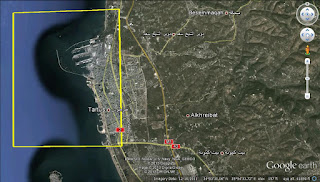Reported by the BBC as
"Syria crisis: Russia 'sends sophisticated weapons'":
 |
| Yakhont Missile |
According to the New York Times report, a recent Russian shipment to Syria included an advanced form of the Yakhont, a 6.7m-long (22ft) missile with a range of 290km (180 miles) and carrying either a high-explosive or armour-piercing warhead.
UPDATE:
NYTimes reports(along the line of Steeljaw's question in the comments below) that these are
new and improved Yakhonts:
Russia has previously provided a version of the missiles, called Yakhonts, to Syria. But those delivered recently are outfitted with an advanced radar that makes them more effective, according to American officials who are familiar with classified intelligence reports and would only discuss the shipment on the basis of anonymity.
Yep, it is a order fulfillment from some time ago - one warned of
here in 2010:
Four decades later, the P800 Yakhont is far superior than the Styx missiles that failed to protect the Syrian Navy in 1973. Much like the Russian-Indian Brahmos, the earlier Moskit and Supersonic Alpha, Yakhont has the capability to strike its target at supersonic speed, flying
 |
| Arrow points to Tartus |
at very low level, leaving the defender much shorter time to react.
***
AEGIS systems, used on U.S. Navy and many NATO vessels, the European PAAMS, used by the Royal Navy, French and Italian navies and Israel’s new Barak 8 ship air defense system are designed to match such treats. So does Israel’s ‘Magic Wand’ system, employing the Stunner missile interceptor, capable to counter these potent missiles effectively if employed in surface/surface or ship/surface role.
More on the Yakhont
here. 180 mile/300 km maximum range spells some danger to near shore forces, but probably not so much to ships operations in "bluer" water.
 |
| Box is around Port of Tartus |
The BBC also notes:
Another US newspaper, the Wall Street Journal (see here), reports that Moscow has deployed at least a dozen warships to patrol waters near the Russian naval base in the Syrian city of Tartus.
 |
| Bora Class Guided Missile Corvette Samum |
Hmmm. I guess if you have only one friend in the area, you gotta stand by and protect your warm water naval base.
More on that base
here.
Our friend Cem Devrim Yaylalı (a/k/a Saturn5) has been keeping track of Russian warship traffic through the
Turkish Straits, including a
new visitor to those waters which appears to have returned home.





300km is the limit under MTCR for cruise missiles in general - any guarantees that was what was shipped to the Syrians? Would also note there are more pieces to this puzzle that are in play - a lot more.
ReplyDeleteSJS: Your sources may be better than my sources in which case, I will be happy to have anything you can share. I suspect the Iranians and the Russians and the Chinese have lots of hot irons in the fire.
DeleteAnd I bet Israel is getting edgy.
Surprisingly, (may be not) the Chinese are keeping their distance. Don't forget to add Lebanese Hizbollah into the equation too. Remember, they are the ones that shot the two C802's that hit the INS Hanit and sank the Egyptian freighter off Beirut in '07. So yeah, the Israelies are plenty edgy, the Syrians (and Russians) know it and thus far, have acted accordingly. The 2x strikes a couple of weekends ago also sent a pretty strong message, both in terms of what was hit and more importantly - how ;)
ReplyDeletew/r, SJS
Sounds like old times are back in the Med, hopefully the Syrians are on the same maintenance system as the Egyptians were (I hadn't realised that the missile launchers on Osas were covered in plywood, until I saw one delaminating in Alexandria).
ReplyDeleteHaving the Russians colocated at Tartas strikes me as one of the bigger problems for dealing with this, especially if both they and the Syrians are deploying some of the same classes of ship/PB there.
Fun times
Shadow